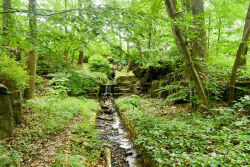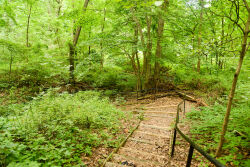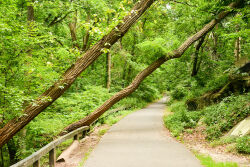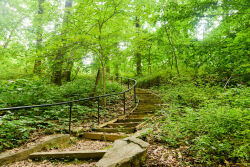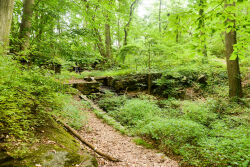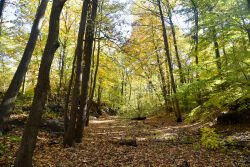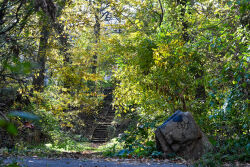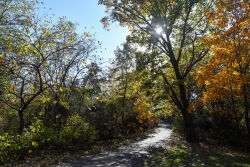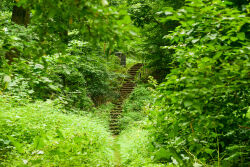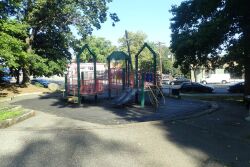Seton Falls Park
The Daily Plant : Tuesday, May 7, 2002
NEW DEPUTY CHIEFS OF OPERATIONS NAMED IN FOUR BOROUGHS
Lynda Ricciardone, Christine Rumpf, and Tom Russo have been appointed Deputy Chief of Operations for Brooklyn, Staten Island, and the Bronx, respectively. Larry Scoones has also been reassigned from Staten Island to Manhattan as the Deputy Chief of Operations. "Some of the top talent in Operations applied for these positions, making the decisions difficult," said Liam Kavanagh, Deputy Commissioner for Operations. "We’re confident we have great candidates for these openings and a strong bench for the future."
Commissioner Benepe commended the three new selections as well as the transfer, noting that the leading candidates emerged from a rigorous and open posting and panel interview process. "There were a great many qualified candidates and strong competition," said Commissioner Benepe. "It’s good to know that there are dedicated Parkies awaiting new challenges."
Lynda Ricciardone has been appointed as Brooklyn’s Deputy Chief of Operations. Ricciardone joined Parks during the summer of 1985 as a Playground Assistant in Staten Island. She was climbing the recreation ranks, eventually becoming Chief of Recreation in Manhattan. Since 2000, she has been a PRM in Brooklyn, overseeing the Borough Garage, Blitz Crews and District 1. Lynda replaces K.C. Sahl who is now the Administrator for Riverside Park.
Christine Rumpf has been appointed Deputy Chief of Operations for Staten Island. Rumpf’s most recent position was as a PRM overseeing Districts 5, 8, 9 and 16 in Brooklyn as well as managing Brooklyn’s pools. She joined Parks in 1979 as an Office Aide in Staten Island. As a resident of Staten Island, she is making that borough both her professional and her personal headquarters. Rumpf is replacing Larry Scoones who will return to Manhattan.
Thomas Russo has been appointed Deputy Chief of Operations for the Bronx. Russo joined Parks in 1989 as the Assistant to the Queens Forestry Highway Inspector and most recently served as the Director of Landscape Management in Queens, the largest in the City. In that position he managed all phases of the Queens Forestry operation. Tom is replacing John Bachman who was promoted to Chief of Operations for Bronx.
Lawrence Scoones has been reassigned as Deputy Chief of Operations for Manhattan. Larry started with Parks as an Urban Park Ranger in 1985. For many years he was a Principal Park Supervisor in Manhattan and served as PRM for Districts 8 and 8 in Manhattan. Most recently he was the Deputy Chief of Operations in Staten Island and as a Manhattan resident, this move bring him closer to home. Scoones replaces Namshik Yoon who was recently promoted to Manhattan Chief of Operations.
HERPS AND HERPERS
Watching the mist rise from a glacial kettle pond as light rain falls and the "quack quack" of wood frogs begins; kneeling in a cool clear stream watching salamander larvae walk along the gravelly bottom; feeling the jelly-like egg clusters of the spotted salamander in the cold waters of March; marveling at the almost impossible swiftness of the ribbon snake startled from its basking place – these are but a few of the experiences a dedicated "herper" can enjoy in New York City. New York City has nurtured both "herps" (reptiles and amphibians) and herpetologists (those who study herps) and continues to support many of the reptiles and amphibians that early naturalists found in its ponds, streams, forests, fields, beaches and marshes.
This year marks the tenth year of herpetological surveys by Parks’ Natural Resources Group (NRG). Headed by NRG’s wildlife biologist/ecologist, the project seeks to determine the present distribution of reptiles and amphibians in parklands and other natural areas of New York City. Parks uses this information to set acquisition priorities, make management decisions, design and monitor habitat restorations, conduct educational programs, and assess the status of the City’s wild areas. Amphibians are well-known indicators of ecosystem health because of their permeable skin and their need to live in moist or aquatic habitats. Reptiles are extremely vulnerable to forest fragmentation and road construction. By comparing present and past distributions of amphibians and reptiles, and by noting ongoing changes, NRG can uncover hidden threats to wetlands and forests while damage may still be reversible.
Renamed "HerpQuest" in 2001, NRG’s herpetological survey has documented amphibians and reptiles in every borough. The most common amphibian, the red-backed salamander (Plethodon cinereus), can be found in woodlands surrounded by asphalt and concrete, such as Manhattan’s Inwood Hill Park and the Bronx’s Seton Falls Park. The northern brown snake (Storeria dekayi) thrives at the Bronx’s Givans Creek Woods in an abandoned lot overgrown with mugwort (Artemesia vulgaris) and other invasive plants, as well as in native vegetation of open woodlands, marshes, and grasslands. At the other extreme, HerpQuest tracks species that are rare within the City’s boundaries, such as the northern ringneck snake (Diadophis punctatus), found on Staten Island’s serpentine barrens, the northern red salamander (Pseudotriton ruber) from Staten Island’s rocky streams, and the spotted salamander (Ambystoma maculatum), now breeding in only two parks in Queens.
Two research projects have arisen from NRG’s herpetological survey. The EPA-funded Urban Stream Monitoring Program is documenting distribution and abundance of stream salamanders as indicators of water and habitat quality. The Terrestrial Salamander Monitoring Program, funded by the Hudson River Foundation, uses volunteers and staff to evaluate forest habitat through abundances of red-backed salamanders.
With NRG looking out for them, NYC’s slimy and scaly critters can be assured a voice on their behalf in any decisions affecting their wild homes. They depend on the City’s human residents for their survival, and, in turn, can alert Homo sapiens to threats that may affect the health and lives of other wildlife and humans themselves.
Written by NRG’s Ellen Pehek
QUOTATION FOR THE DAY
"The world and life’s too big to pass for a dream,"
Robert Browning
(May 7, 1812–1889)


